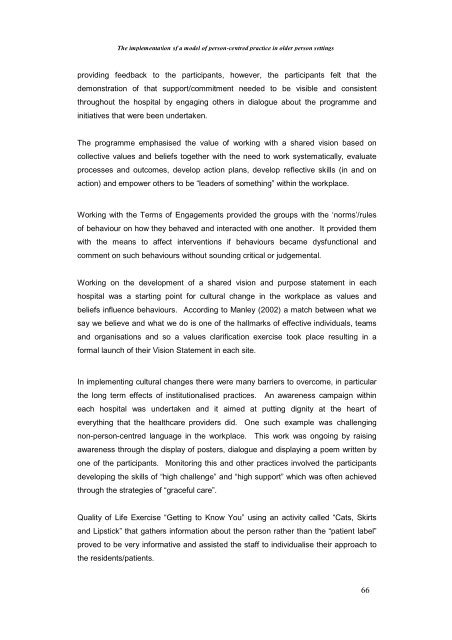The Implementation of a Model of Person-Centred Practice In Older ...
The Implementation of a Model of Person-Centred Practice In Older ...
The Implementation of a Model of Person-Centred Practice In Older ...
Create successful ePaper yourself
Turn your PDF publications into a flip-book with our unique Google optimized e-Paper software.
<strong>The</strong> implementation <strong>of</strong> a model <strong>of</strong> person-centred practice in older person settings<br />
providing feedback to the participants, however, the participants felt that the<br />
demonstration <strong>of</strong> that support/commitment needed to be visible and consistent<br />
throughout the hospital by engaging others in dialogue about the programme and<br />
initiatives that were been undertaken.<br />
<strong>The</strong> programme emphasised the value <strong>of</strong> working with a shared vision based on<br />
collective values and beliefs together with the need to work systematically, evaluate<br />
processes and outcomes, develop action plans, develop reflective skills (in and on<br />
action) and empower others to be “leaders <strong>of</strong> something” within the workplace.<br />
Working with the Terms <strong>of</strong> Engagements provided the groups with the ‘norms’/rules<br />
<strong>of</strong> behaviour on how they behaved and interacted with one another. It provided them<br />
with the means to affect interventions if behaviours became dysfunctional and<br />
comment on such behaviours without sounding critical or judgemental.<br />
Working on the development <strong>of</strong> a shared vision and purpose statement in each<br />
hospital was a starting point for cultural change in the workplace as values and<br />
beliefs influence behaviours. According to Manley (2002) a match between what we<br />
say we believe and what we do is one <strong>of</strong> the hallmarks <strong>of</strong> effective individuals, teams<br />
and organisations and so a values clarification exercise took place resulting in a<br />
formal launch <strong>of</strong> their Vision Statement in each site.<br />
<strong>In</strong> implementing cultural changes there were many barriers to overcome, in particular<br />
the long term effects <strong>of</strong> institutionalised practices. An awareness campaign within<br />
each hospital was undertaken and it aimed at putting dignity at the heart <strong>of</strong><br />
everything that the healthcare providers did. One such example was challenging<br />
non-person-centred language in the workplace. This work was ongoing by raising<br />
awareness through the display <strong>of</strong> posters, dialogue and displaying a poem written by<br />
one <strong>of</strong> the participants. Monitoring this and other practices involved the participants<br />
developing the skills <strong>of</strong> “high challenge” and “high support” which was <strong>of</strong>ten achieved<br />
through the strategies <strong>of</strong> “graceful care”.<br />
Quality <strong>of</strong> Life Exercise “Getting to Know You” using an activity called “Cats, Skirts<br />
and Lipstick” that gathers information about the person rather than the “patient label”<br />
proved to be very informative and assisted the staff to individualise their approach to<br />
the residents/patients.<br />
66
















